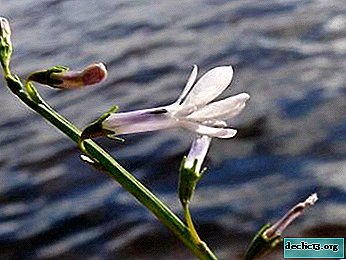Does agave blossom when and how does it happen?

Agave is the closest relative of cactus, haworthia and aloe. Being a native of Mexico, it is a perennial plant without stem-shaped rosettes.
It is popular for landscaping winter gardens and premises, as well as for the decoration of flower beds and parks. But they also grow agave in apartment conditions - dwarf and young specimens. It has a domestic purpose. Ropes, ropes, nets and fabric are made from plant fibers, as well as from molasses, after evaporation of agave juice, they receive alcohol. The plant is endowed with many healing properties (the healing properties of agave and folk recipes with it are described in this article). We will take a closer look at the conditions under which agave blooms and see how this happens.
How often does flowering occur?
Agave leaves resemble belts of gray, green and blue shades reaching a length of 1.5 m. The inflorescence is a huge apical panicle. Under natural conditions, it can exceed 10 m and have more than 10 thousand flowers.
People say that agave blooms once every 100 years. But in reality, the plant blooms before its death only 1 time.The flowering period occurs in different species and varieties of agave at different times. A flower can throw a peduncle at 15, on the 30th year of growth. Some species bloom in 100 years. However, there are those that do not bloom at all. After flowering, the plant gradually begins to die. But by then the flower stalk is already forming offspring intended for reproduction.
Photo
Next, you can see the photo of how the plant blooms:




Where can a flowering plant be observed?
Not every person is able to see agave flowers. Most lucky are the employees of botanical gardens, parks and those who were lucky at that moment to walk around them. Agave flowering is a sensational event. The media immediately begins to write about him, and many people and scientists are eager to come and see how it blooms.
Conditions
In domestic conditions, it is very rare to wait for the flowering of agave. Much depends on the variety of the flower and the conditions of its maintenance. But even compliance with all conditions will not give guarantees to see how agave blossoms.Agave is a succulent, which is a rather capricious culture. The flower perfectly tolerates dry periods and does not involve the use of special soil.
But for flowering, it is necessary to adhere to some rules for keeping the flower:
- Shine. Agave is a flower that loves good lighting. In order for it to bloom, it should be located on the south side with constant access to sunlight. In darkened places, the succulents will not only not bloom, but will begin to gradually die.
- Temperature. For agave blooming, it is required to maintain an optimum indoor temperature for it from 20 to 28 heat. But the plant is famous for its unpretentiousness. It can tolerate frosts up to 5-8 degrees and hot weather up to 40. At high temperatures, agave falls into stagnation.
- Air humidity. Spraying agave is not recommended. The plant perfectly tolerates heat and low humidity. Avoid drafts to achieve agave bloom.
 Watering. During cold weather, succulent must be watered depending on the temperature in the room. For flowering, a constant optimum temperature should be maintained by heaters and irrigation should be carried out after the topsoil has dried out and even cracked a little. Agave does not tolerate high humidity. The leaves will begin to rot and the plant will die, dropping them.
Watering. During cold weather, succulent must be watered depending on the temperature in the room. For flowering, a constant optimum temperature should be maintained by heaters and irrigation should be carried out after the topsoil has dried out and even cracked a little. Agave does not tolerate high humidity. The leaves will begin to rot and the plant will die, dropping them.Water should be boiled or settled with a temperature not lower than that which contains agave. It is better to dry the flower than to fill it.
- Fertilizer. To agave bloomed, it must be fed. This is done once a month with nitrogen-free fertilizers, since it often provokes the appearance of rot.
Bloom description
The plant has an elongated powerful peduncle. Its top is crowned with an inflorescence in the form of a candelabrum with many small flowers. Their shade depends on the variety of agave. The flowering period lasts 1-2 months. Later, the mother plant progressively dies, leaving behind offspring.
Care
At this time, the plant must be provided with optimal conditions for it without drastic changes. Care should be taken as under normal conditions. To keep the agave blooming longer, keep an eye on the level of light and moisture for the plant.
More information about caring for agave, as well as about the features of its cultivation, was described in a separate article.
Why are there no buds?
This succulent is not a flower, which will delight with its flowers every season.Therefore, be patient. Follow all guidelines for keeping agave at home. However, even this will not be a guarantee that the agave will bloom. Indeed, outside natural conditions, this event occurs extremely rarely.
What will happen after the process?
 If, nevertheless, you are lucky enough to see the flowering of agave in domestic conditions, then you should prepare for the death of the mother's flower. But this may not happen. The condition of the plant depends on where the peduncle appears:
If, nevertheless, you are lucky enough to see the flowering of agave in domestic conditions, then you should prepare for the death of the mother's flower. But this may not happen. The condition of the plant depends on where the peduncle appears:
- If it formed in the middle of the outlet, then the death of the flower is inevitable. All nutrients go to ensure flowering and the mother part of the plant begins to wither and dies, forming young offspring. From them in the future a full-fledged flower will grow.
- If the peduncle appears on the side, then the mother plant can survive.
Agave is a plant that at first glance does not require special care. But in order to enjoy its flowering, it is necessary to provide him with certain simple conditions and constantly maintain them without drastic changes.
Useful video
Watch a video on under what conditions agave blossoms:

 Watering. During cold weather, succulent must be watered depending on the temperature in the room. For flowering, a constant optimum temperature should be maintained by heaters and irrigation should be carried out after the topsoil has dried out and even cracked a little. Agave does not tolerate high humidity. The leaves will begin to rot and the plant will die, dropping them.
Watering. During cold weather, succulent must be watered depending on the temperature in the room. For flowering, a constant optimum temperature should be maintained by heaters and irrigation should be carried out after the topsoil has dried out and even cracked a little. Agave does not tolerate high humidity. The leaves will begin to rot and the plant will die, dropping them.















